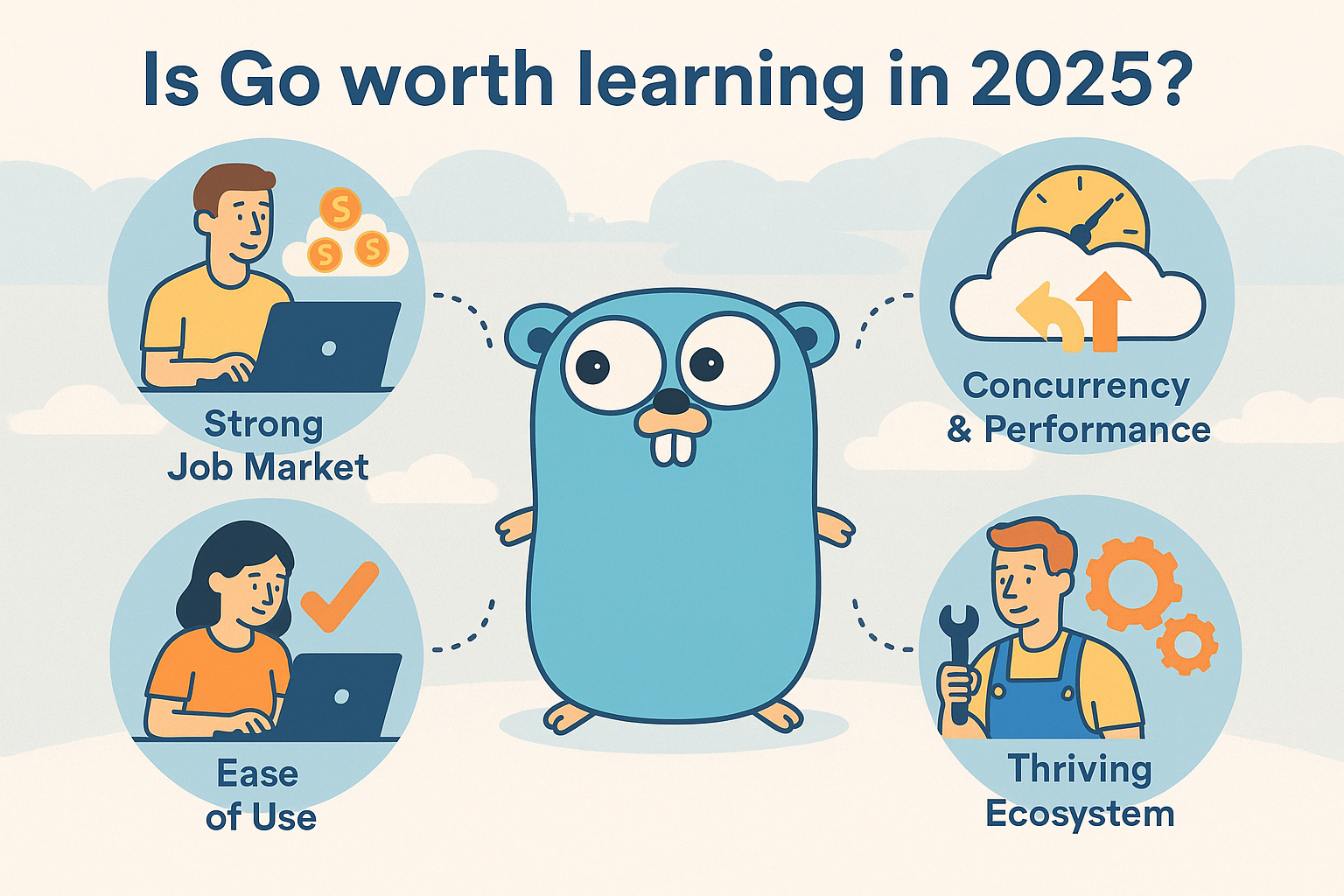The tech world in 2025 is moving faster than ever, with cloud computing, microservices, and scalable infrastructure leading the way.
Go (Golang) was built for exactly this environment, simple, fast, and designed to tackle real-world engineering challenges at scale.
If you're wondering whether it's still a good idea to learn, the short answer is yes and in this article, we'll break down why.
The Job Market Speaks: Go Developers Are in Demand
If you're looking for a language that opens doors, Go is a great pick.
- High Salaries: According to Glassdoor and Golang Cafe, Go developers in the U.S. earn an average salary of around $132,651/year, with entry-level roles starting around $116,000 and senior engineers easily making $170,000+.
- Global Demand: Go isn't just popular in the U.S. — it's gaining traction in Europe, India, Australia, and across Southeast Asia.
- Top Companies Use It: Companies like Google, Uber, Dropbox, and Cloudflare rely on Go for building fast, scalable backend systems.
In short: learning Go can open up some seriously good opportunities.
Go Is Built for What Comes Next
Go was designed to solve modern challenges — and it still shines today.
- Concurrency Built-In: Go's goroutines and channels make it easier to write code that handles many tasks at once, without a headache.
- Cloud-Native Friendly: Lightweight and fast, Go apps fit perfectly into containerized environments like Docker and Kubernetes.
- A Sweet Spot: While Python can be slow and Rust can feel complicated, Go hits a balance between speed, simplicity, and reliability.
Beginner Friendly
One of the best things about Go? It's easy to get started and satisfying to stick with.
- Simple, Readable Syntax: Go keeps things clean and straightforward. You don't need to memorize mountains of rules to write solid code.
- Helpful Standard Library: Need to build a web server or work with files? Go's built-in tools make it easy, no need for huge third-party frameworks.
- Automatic Garbage Collection: Go handles memory management behind the scenes, so you can focus more on building features and less on debugging memory leaks.
Ecosystem Momentum: It's More Than Just a Language
A language is only as strong as its ecosystem and Go's is thriving.
- Huge Open-Source Community: Check out projects on Awesome Go — you'll find everything from web frameworks, CLI tools, machine learning, and more.
- Stable and Evolving: Go is actively maintained with regular releases, keeping it modern without losing its simple, stable foundation. Latest release notes of Go can be found here.
Where Go Really Shines
Go's sweet spot is building real-world, scalable systems. Here's where it truly excels:
🛠 Backend APIs & Microservices
Go's simplicity and performance make it a top choice for building clean, modular APIs. Its concurrency model makes it easy to scale microservices without drowning in complexity.
☁️ Cloud-Native App
Go was practically designed for the cloud. With fast startup times, tiny memory footprints. Go applications are lightweight and highly portable. It's the language of choice for developers building on AWS, GCP, or Azure.
⚙️ DevOps & Infrastructure Tools
Look under the hood of tools like Docker, Kubernetes, and Terraform and you'll find Go. It's become the de facto language for DevOps tooling, thanks to its speed, concurrency support, and ease of cross-compilation.
🚀 High-Traffic Scalable Systems
When your app needs to handle millions of requests per second, Go can build web services and distributed systems that are both blazing fast and resource efficient.
The Learning Curve: Surprisingly Smooth
Learning Go feels refreshingly straightforward.
- Designed to Be Easy: The A Tour of Go tutorial walks you through the basics interactively.
- Amazing Docs: The official Go documentation is one of the most readable and helpful you'll find.
- Community Help: Places like r/golang, Stack Overflow are full of friendly developers happy to help.
Challenges and Misconceptions
No language is perfect, and Go has its limitations:
- Not Great for GUI Apps: While possible, building desktop apps is smoother with other tools.
- Not Focused on Data Science: Python still dominates in ML and data-heavy work.
- Common Myth - "Go is only for Google-scale problems": Totally not true! Go fits perfectly for solo projects, startups, and mid-sized apps too.
Final Verdict: Should You Learn Go in 2025?
✅ Yes!
If you want a language that's simple to learn, powerful to use, and highly in demand, Go is a smart bet for 2025 and beyond.
It's especially great for:
- Backend developers
- Cloud engineers
- DevOps professionals
- Career changers looking for a high-paying, future-proof skill
Learn it, build with it, and watch your career grow.
Bonus: Want More Go Goodness?
If you're serious about leveling up your Go skills, we've got a little bonus for you!
👉 **Join our Go community** and get a free PDF with 10 Go Tips & Tricks
